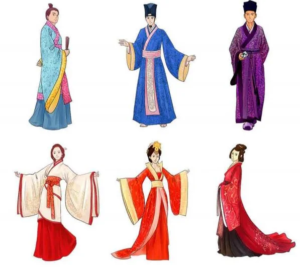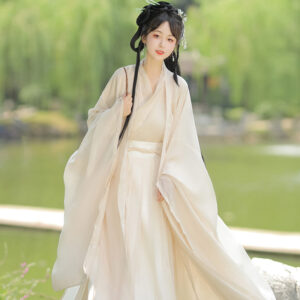

1. Introduction of New Fabrics
- Silk Trade: The Silk Road facilitated the trade of silk, which became a primary material for Hanfu. The availability of high-quality silk allowed for more luxurious and intricate garments, enhancing the overall aesthetic of Hanfu.
- Diverse Textiles: Alongside silk, other fabrics introduced through trade included cotton and wool, which expanded the variety of materials used in Hanfu construction.
2. Color and Dyeing Techniques
- Vibrant Colors: The Silk Road introduced new dyes, such as indigo and safflower, leading to a broader palette of vibrant colors in Hanfu. This shift allowed for more elaborate and colorful garments that reflected the wearer’s status and aesthetic preferences.
- Innovative Techniques: The exchange of dyeing techniques from regions like India and Persia enriched the methods used in fabric coloring, resulting in more intricate patterns.
3. Incorporation of Foreign Patterns and Motifs
- Cultural Fusion: The interaction with various cultures along the Silk Road led to the incorporation of foreign patterns into Hanfu designs. Motifs from Persian and Indian textiles, such as lotuses and geometric shapes, began to appear on Hanfu fabrics.
- Symbolic Representations: These motifs were not merely decorative; they represented a fusion of ideologies and artistic expressions, symbolizing the deepening connection between Eastern and Western cultures.
4. Changes in Garment Structure
- Influence on Silhouette: The traditional flowing lines of Hanfu began to integrate styles from Central Asian fashion, resulting in tighter sleeves and fitted bodices. This adaptation made Hanfu more diverse and suitable for various occasions.
- Practical Adaptations: The need for practical attire for trade and travel influenced the evolution of garment structures, making them more functional while retaining their cultural essence.
5. Embroidery Techniques
- Renaissance in Embroidery: The Silk Road facilitated the exchange of embroidery styles and techniques from different cultures, leading to a renaissance in this art form within Hanfu production.
- New Motifs: Floral and animal designs inspired by foreign influences became popular in Hanfu embroidery, enhancing its beauty and complexity.
6. Lasting Legacy
- Modern Influences: The impact of the Silk Road on Hanfu is still evident today. Modern designs often pay homage to these historical influences by incorporating traditional motifs with contemporary aesthetics.
- Cultural Festivals: The enduring popularity of Hanfu during cultural festivals reflects its rich heritage shaped by centuries of cultural exchange along the Silk Road.
Conclusion
The Silk Road significantly influenced ancient Hanfu styles by introducing new fabrics, colors, patterns, and techniques that enriched its design. This cultural exchange not only transformed Hanfu into a more diverse and vibrant garment but also symbolized the interconnectedness of different civilizations throughout history. The legacy of these influences continues to resonate in contemporary interpretations of Hanfu today.
Share this post
Facebook
Twitter
LinkedIn
Pinterest
Recent Posts


What were the key features of Hanfu during the Tang Dynasty?
October 24, 2024

How did Hanfu styles vary during different Chinese dynasties?
October 24, 2024

What accessories are typically worn with Hanfu?
October 24, 2024

How do you choose the right Hanfu for different seasons?
October 24, 2024

Newsletter
Subscribe for our monthly newsletter to stay updated
Popular Categories
Related Post
Sed aliquam, tortor et sodales malesuada, lorem leo luctus tellus, quis interdum eros nibh in nunc. Cras dignissim malesuada, lorem leo luctus

What are the winter hanfu called?
October 24, 2024

What were the key features of Hanfu during the Tang Dynasty?
October 24, 2024

How did Hanfu styles vary during different Chinese dynasties?
October 24, 2024

What accessories are typically worn with Hanfu?
October 24, 2024

